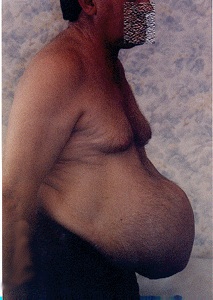Why is the subject of hernia recurrence so important ?
Sir Cecil Wakely – President: Royal College of Surgeons (Eng) 1948 |
There are always risks associated with ANY surgery but the hernia repair performed at this Centre enables us to be more confident than ever against recurrence – for life. Unfortunately, repairs performed elsewhere have historically not proven this reliable and failures can all too often occur at any time in the patient’s lifetime.
Difficulties with older methods
When a hernia repair operation breaks down (i.e. a recurrent hernia), further repair operations are more difficult than the first. To make matters worse the chances of success actually diminish with each successive attempt at repair.
The same is true of the breakdown of the scar in the abdominal wall from an incision for any previous operation. This is called an incisional hernia. Thus the recurrent hernia and the incisional hernia are very similar in many respects, including the difficulties in effecting a reliable repair.
There are also cases of multiple hernias and of combinations of all the above, such as multiple, recurrent hernias or recurrent incisional hernias. These cases pose many difficulties to most surgeons and are not always successfully repaired. Specialised experience can prove very helpful.
Our operations are performed with a variation of the tension-free techniques described elsewhere in this site, with very similar success rates. It enables us to make a much smaller incision via an incision away from that previously performed and the hernia itself is approached from within the weakness in the abdominal muscles achieving a reinforced repair that is far stronger than the one that has failed. There is therefore no need to cut through scar tissue and the described risks to the testis do not apply.
The hernia opening is then completely covered by a larger mesh reinforcement applied from the inside, incorporating and strengthening all the surrounding tissue making it almost impossible for a further recurrence to take place. In effect, the whole area of abdominal wall surrounding the hernia site(s) becomes reinforced not just the area(s) previously operated upon.
We thus eiminate the causes of later, multiple recurrences described above.
Is recovery much slower?
Because our technique avoids the usual, high levels of tissue trauma and the repair is ‘tension-free’ (in the same way as is described earlier for the less complex repairs), there is surprisingly little discomfort and recuperation is just as rapid as after simpler hernia repairs.
Patients are expected to be as active as possible from the first day, e.g. walking 1 to 2 miles, swinging a golf club, and return to completely normal routine often in 4 to 7 days.
What about really complex cases?
Depending on how complex the case, we can still perform some recurrent hernia repairs under local anaesthesia, although the more problematic and most complex cases of neglected hernia, can be performed by this particular procedure with the help of just a light, general anaesthetic.
Factors that decide the approach include how long the patient has left the hernia untreated, how many times it has already been repaired, how large it is, and so on.
In the vast majority of cases, even the more complex ones, the patient still leaves the same day. Only in the most challenging of cases is there a need for overnight hospital stay, and even then normally for only one night. A prior examination will determine which is the most suitable course for each case.
We have a technique perfectly suited to each individual case and in which we have gained unique experience.
The extremely large number of hernia cases seen each year at The British Hernia Centre, added to the experience of tens of thousands of cases we have already performed, puts us in a singular position to offer this superior technique of repair for even the most complex of cases.
For the connection between Recurrent Hernia and Testicles, see the section on Testicular Involvement
